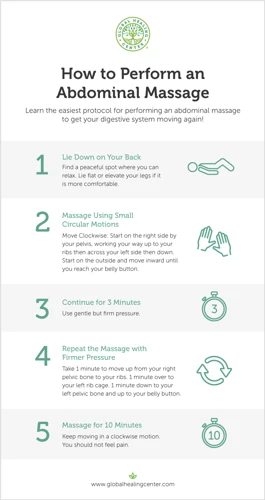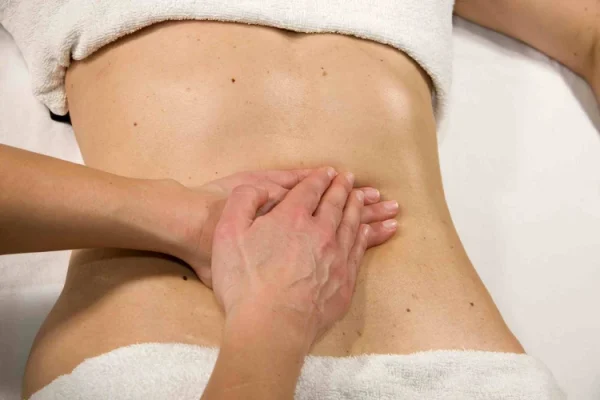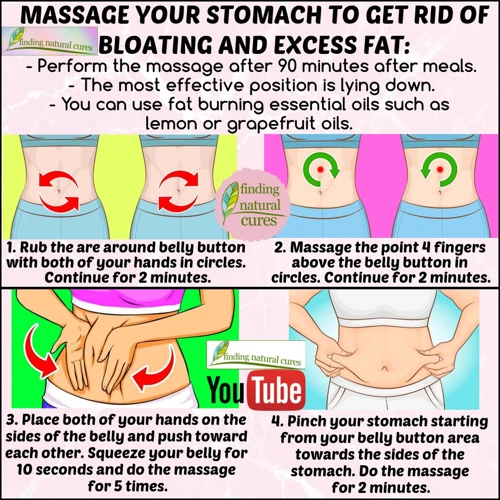Abdominal massage is more than just a relaxation tool—it’s a gentle, hands-on technique that supports digestion, reduces tension, and may help relieve discomfort in the gut.
By applying light pressure to the abdomen, this practice can improve circulation, ease bloating, and calm the nervous system. Some even use it to release emotional stress stored in the body.
In this article, you’ll learn:
- What abdominal massage is
- How it may benefit your body and mind
- Techniques you can try at home
- When to avoid it and why safety matters
Let’s take a closer look at how this simple practice can support your health from the inside out.
Table of Contents
What is Abdominal Massage?

Abdominal massage is a type of massage therapy specifically targeting the abdominal region. It is used to help relieve tension and pain in the abdominal area, as well as to improve digestion and overall health. Abdominal massage can be done manually or with the help of massage tools.
During abdominal massage, gentle pressure is applied to the abdomen in circular motions. This helps to stimulate the internal organs, relax the abdominal muscles, and improve digestion. Abdominal massage also helps to move toxins from the body and reduce stress.
Benefits of Abdominal Massage

Abdominal massage offers a range of health benefits, including improved digestion and improved circulation. It can also help to reduce bloating, reduce cramps, and reduce stress. Abdominal massage can also help to improve the appearance of the skin, reduce inflammation, and improve overall health.
- Relieves Stress – Massaging the abdominal muscles can help release tension and reduce stress.
- Improves Digestion – Abdominal massage can help improve the digestive process by stimulating the digestive organs and muscles.
- Boosts Blood Circulation – Massaging the abdominal area can help improve blood circulation to the organs, supplying them with oxygen and nutrients.
- Reduces Bloating – Abdominal massage can help reduce bloating by improving digestion and removing gas and fluid buildup in the abdomen.
- Increases Relaxation – Abdominal massage can help promote relaxation by soothing the muscles and calming the mind.
By learning how to massage abdominal muscles, you can reap these benefits and more.
Techniques for Abdominal Massage

- Gentle Circular Massage: Start by placing your hands on the lower abdomen and make small, gentle circular motions. This helps to relax and loosen the muscles, as well as improve local circulation.
- Fingertip Massage: Use your fingertips to make small circles on the lower abdomen. This helps to stimulate the digestive system and reduce tension in the abdominal area.
- Stretching: Gently stretch the abdominal muscles using both hands. This helps to improve flexibility and reduce tension.
- Pressing and Rubbing: Use both hands to press and rub the abdomen in a slow, gentle manner. This helps to stimulate the digestive system and reduce tension.
What happens when you massage your belly is that you can help to relax the muscles, improve circulation and reduce tension, which can result in improved digestion and overall health.
What Happens When You Massage Your Belly?

Massaging your belly can help to reduce bloating, relieve digestive issues, and improve circulation. During a massage, pressure is applied to the abdomen with circular motions. This helps to break up the gas bubbles in the intestines, allowing for the release of any gas, toxins, or waste build-up. Massaging the abdomen can also help to relax the muscles, relieving tension and pain. Additionally, it can stimulate blood flow, which helps to improve circulation and reduce abdominal discomfort.
The benefits of abdominal massage are not only physical. It can also help to promote mental relaxation and reduce stress. Massaging the abdomen can help to calm the mind, improve focus, and reduce overall stress levels. It can also help to improve mood and reduce symptoms of depression and anxiety.
Despite these benefits, it is important to note that abdominal massage can cause discomfort in some cases, such as when people massage too hard or too frequently. Additionally, some people may experience mild discomfort or pain when massaging their abdomen. This is often caused by tension in the abdominal muscles or issues in the digestive system. If you experience any discomfort during abdominal massage, it is important to stop and seek advice from a medical professional.
Overall, abdominal massage can provide many physical and mental health benefits. However, it is important to understand why does my stomach hurt when I massage it, as well as the potential risks, before attempting to massage your stomach.
How to Perform an Abdominal Massage: Step-by-Step

Abdominal massage focuses on the muscles around your stomach, sides, and lower back. It’s a gentle, hands-on technique used to release tension, improve circulation, and support digestion.
1. Prepare Your Space
- Lie down comfortably on a flat surface (like a bed, yoga mat, or massage table)
- Use a small pillow under your knees if needed for support
- Warm your hands and your massage oil or lotion to reduce friction
2. Begin with Gentle Stroking
- Place your palms on your abdomen
- Use light, slow strokes in a circular motion
- Start just below your ribs and work your way down toward your lower belly
- This helps relax the muscles and ease you into the massage
3. Apply Firm Pressure
- Gradually increase pressure using your palms or knuckles
- Move in a clockwise direction—this follows the natural path of digestion
- Stay mindful of tender areas and ease off if you feel discomfort
4. Use Your Fingertips
- Make small, slow circles with your fingertips across the lower abdomen
- This can help release deeper tension and stimulate the underlying muscles
5. Stretch the Abdominal Area
- Gently stretch the skin upward and outward using both hands
- This promotes flexibility and encourages deeper breathing
6. Target Pressure Points
- Feel around the abdomen for tight or sensitive spots
- Hold light pressure on each point for about 30 seconds
- Release slowly and move to the next area
- Pressure point work may help release tension and improve blood flow
Tips for Best Results
🧘♀️ Move slowly and breathe deeply
Helps your body relax and respond to the massage.
🍽️ Avoid massaging after a heavy meal
Give your digestive system time to settle first.
⏱️ Limit sessions to 5–10 minutes
Too long can lead to irritation or discomfort.
⚠️ Stop if you feel pain or sharp discomfort
Massage should feel soothing, not painful.
👩⚕️ Check with your doctor if you have medical conditions
Especially important if you have any abdominal issues or recent surgery.

Side Effects and Risks of Abdominal Massage
Abdominal massage is generally safe when done gently and with care. But like any bodywork technique, it can cause side effects—especially if done too aggressively or without proper guidance.
💢 Discomfort or pain
Too much pressure can lead to soreness, especially in tense or sensitive areas. Always start gently and stop if it hurts.
🤢 Nausea or dizziness
Some people feel lightheaded or nauseous during or after a massage. This can happen if pressure is too intense or if the body isn’t used to abdominal stimulation.
💨 Bloating or cramping
Stimulating the abdomen can temporarily trigger gas, bloating, or mild cramps as digestion is activated.
🩹 Skin irritation
Massage oils or lotions may cause a reaction in sensitive skin. Always use a product that suits your skin type and patch-test if needed.
⚠️ Hernia aggravation
If you have a hernia, abdominal massage can increase pressure in the area and may worsen symptoms. Avoid massage over herniated spots.
🟣 Bruising
Vigorous massage can cause bruising, especially if done with too much force or on people with sensitive skin or certain medical conditions.
❌ Rare but serious risks
- Extremely forceful or improper techniques could, in rare cases, harm internal tissues
- Infection is only a concern if tools or hands are unclean or massage is done over open wounds or rashes
- People with blood clotting disorders or vascular issues should consult a doctor before massage
🚫 When to avoid abdominal massage
- During pregnancy (unless approved by a doctor)
- After recent abdominal surgery
- If you have an active hernia, open wounds, skin infections, or unexplained abdominal pain
- If you have a condition like severe IBS, Crohn’s, or endometriosis—speak with a healthcare provider first
Abdominal massage can be a helpful part of your self-care routine—but only when done with care, awareness, and the right technique.
Frequently Asked Questions
What are the Potential Health Benefits of Abdominal Massage?
Abdominal massage can offer a range of health benefits. These include:
- Improving digestion: Massaging the abdomen can help stimulate digestion and reduce bloating, constipation and gas.
- Reducing stress: Abdominal massage can help release tension in the abdominal area and help reduce stress.
- Improving circulation: Abdominal massage can help improve blood flow to the abdominal area and other organs.
- Strengthening the immune system: Massaging the abdomen can help boost the immune system by stimulating the lymphatic system.
- Reducing pain: Abdominal massage can help reduce pain in the abdominal area and other parts of the body.
- Promoting relaxation: Massaging the abdomen can help you relax and improve your overall well-being.
How often should abdominal massage be performed?
- Daily: Abdominal massage can be done every day as part of a self-care routine.
- Weekly: If abdominal massage is done as part of a treatment plan, it can be done once or twice a week.
- Monthly: Abdominal massage can be done a few times a month for maintenance.
It is recommended that abdominal massage be done regularly, to ensure the best results. However, it is important to speak to a healthcare provider to determine the best frequency for each individual.
Why Does My Stomach Hurt When I Massage It?
Abdominal massage is generally safe and beneficial—but if you feel pain during or after, it’s a sign that something isn’t right. Here are some common reasons this can happen:
💢 Muscle Spasms
Tight or tense abdominal muscles may react to pressure by spasming. This can happen if you:
- Use too much pressure
- Have poor posture
- Are dehydrated or holding tension in your core
💨 Irritable Bowel Syndrome (IBS)
People with IBS may have heightened sensitivity in the gut. Even gentle massage can trigger discomfort by stimulating sensitive nerves and tissues in the digestive tract.
🩸 Endometriosis
If you have endometriosis, abdominal massage may press on areas of internal inflammation or tissue buildup. This can cause sharp or cramping pain, especially during certain points in your cycle.
⚠️ Hernia
A hernia occurs when an internal organ pushes through a weak spot in your abdominal wall. Massage in that area can increase pressure and lead to pain—or worsen the condition.
✅ What to Do If It Hurts
- Stop the massage if you feel sharp, deep, or lingering pain
- Use lighter pressure and only gentle motions
- Check with your doctor if you have any digestive conditions or recent abdominal issues
- Hydrate and rest—especially if your core is tight or tense
When in doubt, always listen to your body. Abdominal massage can be helpful—but only when done gently and with awareness of your individual health needs.
Conclusion
Abdominal massage is a form of massage therapy that has many potential benefits, such as relieving pain and tension, improving digestive health, and improving overall wellbeing. This massage technique can be used to target specific areas of the abdomen, such as the upper or lower abdominal area. It can also be used as part of a larger, full-body massage. Different techniques and strokes can be used to target different areas, so it is important to consult with a massage therapist to determine the best approach for you.
📖 Also Read:
📚 References
- A Systematic Review of Abdominal Massage for Constipation and Gastrointestinal Conditions
- Abdominal Massage – James Cook University
⚠️ Disclaimer:
This article is for informational purposes only and does not constitute medical advice. Always consult with a licensed healthcare provider or certified massage therapist before beginning any new treatment, especially if you have pre-existing health conditions or concerns.













